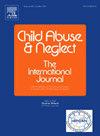Bullying victimization and self-harm in adolescents: The roles of emotion regulation and bullying peer norms
IF 3.4
2区 心理学
Q1 FAMILY STUDIES
引用次数: 0
Abstract
Background
While prior research has suggested that experiencing bullying victimization increases the risk of self-harm, the exact role of intrapersonal emotion regulation and bullying peer norms in contributing to this association are not fully understood.
Objective
This study examined the mediating effects of cognitive reappraisal and expressive suppression and the moderating effects of bullying descriptive and popularity norms on the association between bullying victimization and self-harm.
Participants and setting
A total of 3545 Chinese adolescents (52.4 % boys; Mage = 12.36 years; 90.9 % Han nationality) from 76 classes participated in the current study.
Methods
Data were collected in two waves, spaced six months apart. Participants completed self-report questionnaires regarding bullying victimization, bullying perpetration, emotion regulation and self-harm. Peer nomination items were used to assess bullying perpetration and popularity.
Results
The study found that bullying victimization was linked to an increase in self-harm six month later, both directly and indirectly, by enhancing the use of expressive suppression. The effects of expressive suppression as a mediator were notably stronger in environments with low bullying descriptive norms or high bullying popularity norms.
Conclusions
These findings provide insights into the mechanisms by which bullying peer norms adversely affect emotion regulation and escalate self-harming behaviors among victimized adolescents. Effective bullying prevention and intervention strategies should focus not only on reducing bullying behaviors, but also on addressing maladaptive emotion regulation strategies such as expressive suppression. Additionally, fostering a classroom environment characterized by non-aggressive and prosocial norms is crucial for mitigating the negative outcomes associated with bullying.
青少年受欺凌与自残:情绪调节和欺凌同伴规范的作用。
背景:虽然先前的研究表明,经历欺凌受害者会增加自我伤害的风险,但个人情绪调节和欺凌同伴规范在这种关联中的确切作用尚未完全了解。目的:研究霸凌描述性规范和受欢迎性规范在霸凌受害与自我伤害关系中的调节作用,以及认知重评价和表达抑制的中介作用。参与者和环境:共有3545名中国青少年(52.4%的男孩;法师= 12.36岁;76个班级的90.9%汉族学生参与了本研究。方法:分两波采集,每波间隔6个月。被试完成欺凌受害、欺凌行为、情绪调节和自我伤害自述问卷。同伴提名项目被用来评估欺凌行为和受欢迎程度。结果:研究发现,欺凌受害者与六个月后自我伤害的增加有直接和间接的联系,通过增强表达性抑制的使用。在低恃强凌弱描述性规范和高恃强凌弱流行性规范的环境中,表达抑制作为中介的作用显著增强。结论:研究结果揭示了欺凌同伴规范对青少年情绪调节的负面影响和自我伤害行为升级的机制。有效的欺凌预防和干预策略不仅应着眼于减少欺凌行为,还应关注表达抑制等适应不良情绪调节策略。此外,培养一个以非攻击性和亲社会规范为特征的课堂环境对于减轻与欺凌相关的负面结果至关重要。
本文章由计算机程序翻译,如有差异,请以英文原文为准。
求助全文
约1分钟内获得全文
求助全文
来源期刊

Child Abuse & Neglect
Multiple-
CiteScore
7.40
自引率
10.40%
发文量
397
期刊介绍:
Official Publication of the International Society for Prevention of Child Abuse and Neglect. Child Abuse & Neglect The International Journal, provides an international, multidisciplinary forum on all aspects of child abuse and neglect, with special emphasis on prevention and treatment; the scope extends further to all those aspects of life which either favor or hinder child development. While contributions will primarily be from the fields of psychology, psychiatry, social work, medicine, nursing, law enforcement, legislature, education, and anthropology, the Journal encourages the concerned lay individual and child-oriented advocate organizations to contribute.
 求助内容:
求助内容: 应助结果提醒方式:
应助结果提醒方式:


